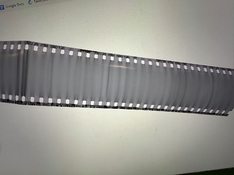I asked about fixer on the reels because, coupled with low agitation, I think that can cause silvering-out on what would normally be bromide drag lines.
I doubt it; the bromide drag lines would only occur in areas that have density (resulting from exposure) to begin with, since bromide drag is minus density due to bromide inhibition of the development process (hence the term). So that rules out bromide drag and if your fixer hypothesis relies on it, that would be ruled out as well.
Instant silvering out due to fixer contamination (sans the bromide drag component) I find a little hard to believe especially in this clearly defined pattern and without any mention of a silvery sheen on the film. Fixer contamination I'd expect to show up as one of the following:
1: Slight brown discoloration of the entire film due to sulfur compounds indiscriminately forming silver sulfide.
2: Slightly reduced overall gamma - which would go unnoticed unless the contamination is really bad. It's basically the same as adding a little fixer to the first developer in a reversal process (and that doesn't result in silvering out either).
3: Distinct ammonia / fishy smell during development - which may easily go unnoticed especially by someone who hasn't processed a whole lot of film.
4: Most probably: overall dichroic fog with no distinct pattern to it.
Given the pattern we see here, I don't really see how fixer would be responsible for it. Yes, I get the argument of fixer sticking to reels and that way only being 'active' locally...but with this particular pattern, and such 'good' definition to the pattern? Nah.
The over-agitation hypothesis also sounds far-fetched; why doesn't everyone running a Jobo at continuous rotation run into this problem? And even if there's over-agitation, how come it shows up as (lots of!) density in supposedly unexposed areas of the film? The excess agitation somehow sped up a development process that...doesn't happen in the first place? And how about those places where the pattern is fairly sharply cut off? I've over-agitated film lots of time; it's easy to run into the problem with e.g. x-ray film. What you get is excess
gamma in a pattern that's consistent with flow patterns and things like tank/tray geometry. What it doesn't create, is sharply defined density in unexposed areas of the film.
While fogging to light - well, makes perfect sense. Light shines through sprocket holes and falls onto emulsion underneath. ]The only question is where/when it exactly happened. Now
that is a question that's going to help OP towards a solution. Hence my surprise and slight frustration about the red herrings that are served out for reasons that are unclear to me. Maybe it's somehow not good enough to stick to the most likely hypothesis and work that out?
Well, that's the way I see it. And now I'll
really try and not argue the point any further. I apologize for having done so to begin with and will leave anyone to pursue whatever direction the see fit, regardless of how irrelevant I believe it is.









